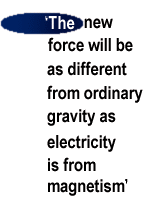
general relativity in which the gravity of the Sun, for example, is no longer a force but a distortion in the very fabric of the Universe. A simple analogy is the way in which a heavy ball sitting on a rubber sheet distorts it, making an indentation, so that any small objects in the vicinity tend to roll towards it. The Earth may seem to follow an elliptical orbit around the Sun, says Francis Everitt, the British-born physicist who heads the Gravity Probe B project at Stanford University in California, "but what it's actually doing is following straight lines in curved space-time". Gravity Probe B is now taking shape in Everitt's laboratory. General relativity neatly avoids the problem of instantaneous transmission, but is it true? Relativity makes several predictions that allow it to be tested. Starlight, for example, should be influenced by a gravitational field and the elliptical orbit of Mercury should gradually turn in its plane. Both of these effects have been observed, but physicists want more.
A Big Drag
Relativity also predicts that when a massive object rotates it tends to drag space and time with it. This effect is known as frame dragging and it should manifest itself as a force that pushes a gyroscope's axis out of alignment as it orbits the Earth. Gravity Probe B will attempt to measure the force, gravitomagnetism, giving scientists an important insight into how it might affect objects that are much larger than ping pong balls, such as black holes.At the same time, the gyroscopes will experience a much bigger force the geodetic effect which is a result of the warping of space-time predicted by Einstein (see Diagram). This force will tend to push their axes in a direction perpendicular to the frame-dragging effect which allow it to be measured separately.The geodetic effect is hundreds of times bigger than frame dragging and the experiment should measure its size with an accuracy of 0.01 per cent the most severe test of general relativity ever undertaken.
While the geodetic effect was first detected in 1988, gravitomagnetism has remained hidden because it is extremely weak. To get some idea of how weak it is, imagine that the axes of the spinning spheres are a kilometre long. In the course of a year, this force would move the ends of the axes by the width of a human hair, an angle of only 40 milliarcseconds. Gravity Probe B is designed to measure this effect with an accuracy of 1 per cent but it will be no easy task the slightest interference from unwanted forces will overwhelm the results.
